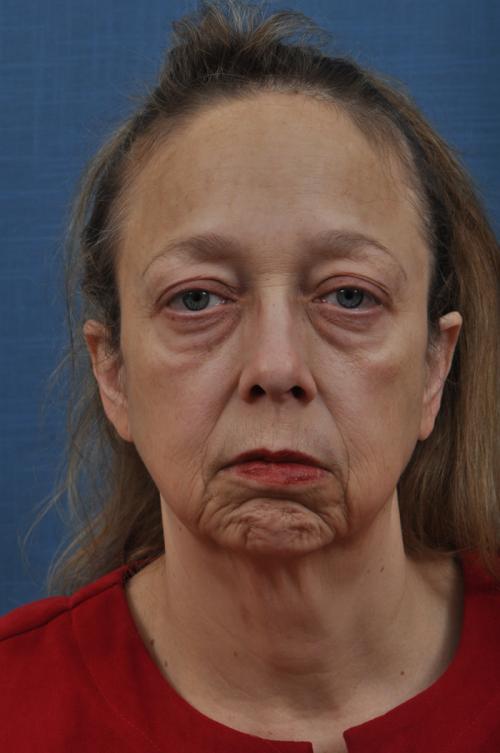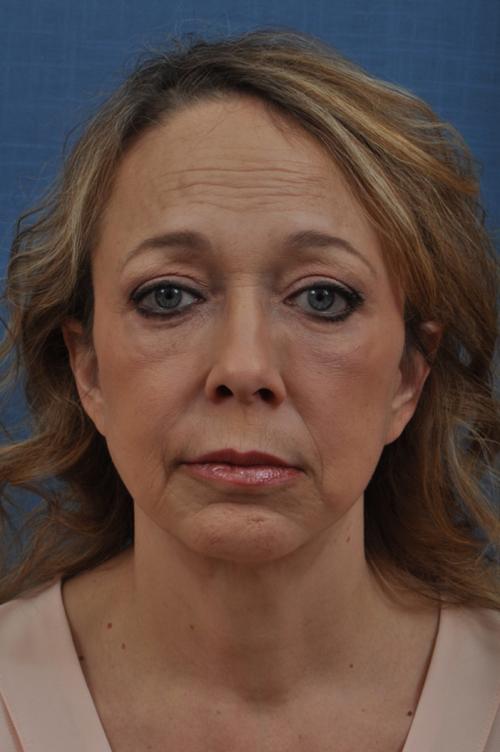Deep Plane Facelift in Memphis, TN, with Dr. Phillip R. Langsdon

Dr. Phillip R. Langsdon is among a small group of very highly experienced plastic surgeons who perform the Deep Plane Facelift, and he developed techniques that many of the leading facelift surgeons have adopted. The deep plane facelift works by lifting the underlying muscle and fascia layer in order to reposition the drooping facial muscles sheath so that a restoration of the upper, mid-face, and jowl is accomplished without stretching the skin.
When the deep plane technique is used along with Dr. Langsdon’s neck techniques, many patients may enjoy a “natural” restoration of the cheek, jawline, and neck.
In some instances, the neckline is better than before the aging process started.
Read on to learn more about Memphis deep plane facelift at The Langsdon Clinic, a nationally renowned center for facial plastic surgery. You can also call 901-755-6465 or contact us online today to book your consultation with Dr. Langsdon, a leading authority in the deep plane facelift procedure.
Dr. Langsdon’s Deep Plane Facelift Technique
The face is comprised of several layers. The outer layer is composed of the skin. The middle layer is made of a superficial muscle and fascia system, called the superficial muscular aponeurotic layer (SMAS).
The SMAS layer runs from the top of the head, down to the collar bones, and separates the skin of the face from the deeper tissue. The layer has loose connections to the skin in some areas and tighter connections in other areas. Below the SMAS are the deep muscles of facial expression, which is the layer that allows us to smile, frown, etc.
While more commonplace or traditional facelifts depend on pulling the skin, the deep plane facelift elevates the entire mid-level muscle layer and releases some of the ligaments between the deepest layer and the middle layer (SMAS). Because of the connections from the SMAS to the skin surface, the entire face is lifted in a manner that avoids the stretched look that we often see in some celebrities or people in public mediums.
Deep Plane Facelift Before and After Photos
As a leading facial plastic surgeon, Dr. Langsdon has published articles that describe the application of various techniques used to provide excellent and natural-looking results and has spoken on these techniques for over 20 years.
Who is a Good Candidate for a Deep Plane Facelift?
In today’s internet & social media environment, many patients may be led to believe they need extensive surgery when it may not, in fact, be beneficial. Dr. Langsdon will help each patient understand when the deep plane technique or other facelift techniques are needed to provide the most natural-looking result in their specific situation. Dr. Langsdon only recommends for each patient what they truly need to improve the condition in question, and if you won’t benefit from a procedure, he will not recommend it.
How Does Deep Plane Facelift Surgery Provide Natural-Looking Results?
There are numerous factors that Dr. Langsdon will consider when performing a deep plane facelift:
The depth and layer of tissue movement is important in determining a natural result. The deep plane technique works by lifting “under” the SMAS but avoids the muscles that help us move our face to smile, frown, etc. By lifting in the deep plane, we also prevent the direct pull on the overlying skin, which can cause a “stretched,” “pulled,” or “windblown” look.
The direction of pull also determines how we look. For over four decades, expert surgeons have known that a “backward” pull contributes to a stretched look, especially around the mouth, and an oblique (backward and upward direction) provides a more natural appearance. Understanding the importance of the direction of tissue repositioning is nothing new, despite the claims on the internet that some doctors have “invented or discovered” the importance of the direction of pull. In fact, even a deep plane lift can distort a person’s face when the pull is in an extreme manner.
The extent of lifting also determines whether there is a more natural look or an “odd” configuration of the face. Overdoing surgery can distort one’s face, no matter what plane the doctor operates in. Attached in the “deep plane” under the SMAS are ligaments that hold the facial tissue to the deeper lining near the bone. While some deep plane facelift surgeons divide all the ligaments in a routine manner, this can cause an “odd” or “misshapen” look to the face if some of those ligaments are needed to maintain normal tissue position. In fact, we have had patients from all over the U.S. consult us because of “over movement of the deep plane.” Instead, we craft each person’s surgery (and ligament division) to what needs to be elevated in order to preserve a natural yet more youthful appearance. That odd, distorted appearance (sometimes called the “joker face”) usually occurs because of various maneuvers such as “pulled skin,” “misdirection of the pull on the lift,” or “deep plane undermining that is too extensive with too many ligaments removed.” Dr. Langsdon believes that not all ligaments should be released in all patients in a “one size fits all” facelift technique. He crafts each surgery to what each patient needs.
The degree of improvement in the neck also determines the outcome from some facelift-type procedures: Some doctors treat the neck with only fat suctioning when perhaps more is needed. Or, some doctors promote extensive lifting of the upper face tissue to pull up the neck, when in some instances actual work in the neck is needed. Others limit their neck work to simple midline suturing of the SMAS layer muscle (platysmaplasty) in the neck. Dr. Langsdon invented and developed the SMMS (submental muscular medialization and suspension technique), which tightens and raises sagging muscles in the neck. Although this technique is not indicated in all situations, and some of the other above techniques can help many patients, his SMMS technique helps many patients with heavy tissues obtain a neckline much better than with older traditional facelift techniques. In some patients, this can improve the neckline better than one had during youth, before aging set in.
Meet Dr. Langsdon
President of the American Academy of Facial Plastic and Reconstructive Surgery, 2018
Phillip R. Langsdon, M.D. is a Clinical Professor. Dr. Langsdon’s career has been limited and focused entirely on Facial Plastic Surgery and he has dedicated himself to the pursuit of excellence in his field.
Why Choose Dr. Langsdon as Your Deep Plane Facelift Surgeon?
Among the Best Facelift Surgeons in the US
Doctor Langsdon is a sub-specialized facial plastic surgeon and one of the best facelift surgeons in America and the world. He specializes in the deep plane facelift and multiple types of facelifts that provide natural-looking results without the need for general gas anesthesia. He has performed thousands of procedures, and patients come from not only the region but from all over the U.S., Europe, Asia, Australia, New Zealand. He is a published author, innovator, and inventor in facelift and neck lift techniques that have set a standard that many leading facelift surgeons have adopted. He has presented his methods to doctors from all over the U.S. and world in over 300 speaking appearances and has trained over 90 doctors in facelifting techniques at his facility in Germantown/Memphis, Tennessee. He served as President of the American Academy of Facial Plastic & Reconstructive Surgery (AAFPRS). He has overseen the facelift education of thousands of surgeons from all over the U.S. and the world by serving as AAFPRS national medical education meeting director and as a CME (continuing medical education) meeting director for the Foundation of Facial Aesthetic Surgery for over 25 years.
A Leading Authority on Deep Plane Facelifts
Doctor Langsdon described many of the techniques and that provide natural looking results for the face and neck in peer reviewed medical articles, book chapters and a medical textbook. He invented and was the first to write and speak about the deep plane SMMS technique that provides a vast improvement in the most difficult, thick and obtuse necks. He first published the SMMS technique in 2012, with additional articles in 2013 and 2018.
View Dr. Langsdon’s Publications
Innovative Techniques with Natural-Looking Results
Dr. Langsdon’s deep plane facelift techniques avoid that “done,” “windblown,” or “stretched” look that is often seen in many celebrities and media personalities. Dr. Langdon’s techniques are state-of-the-art and designed to provide maximum improvement possible in the neck and face. His techniques are crafted specifically for each patient with the goal of a natural-looking result. He does not believe in a “one size fits all” approach or that all patients are candidates for a deep plane technique. Dr. Langsdon’s innovative methods are customized to what each patient needs. While some patients need an extensive deep plane and ligament treatment, some keep a natural result by preserving some of those ligaments. Each person’s procedure is customized to her/his anatomy and needs.
How Long Does a Deep Plane Facelift Last?
No operation can prevent further aging, but with our techniques, the hands of time may be turned back, and one usually does not appear as old as one would have, had surgery never been performed. Individuals age at their own inherent rate. Your natural degenerative processes determine the rate at which some sagging will re-develop. No one can accurately predict this because all individuals are different.
In ideal cases, the duration of time before needing a tuck up may be from one to ten years or longer, depending on where one is in the aging process of life, how much elasticity is already lost, the rate the elasticity is deteriorating, your genetics, health, social habits, etc.
If one is rapidly losing elastic properties in his/her skin and muscle, a tuck up may be needed sooner. If you are aging slowly, it may take years before needing a tuck up. Importantly, regardless of the age of the patient, who does the surgery, how much (or what) is done, or any “so called” preventative measures, some slack may be found within a few months after surgery.
During our surgical process, we reposition the muscle and skin as much as possible. However, there is a tissue tolerance point in the muscle and other tissues; beyond that point, the sutures would pull through the tissues and muscle. Remember, with a facelift the sagging muscle/fascia are repositioned and the excess tissue and skin are removed, but the skin, fascia, and muscle possess the elasticity you are genetically determined to have. This genetic factor does not change with any type of surgery, and your own elastic properties will weaken with age.
A tuck-up procedure may be recommended in the future when your tissue relaxation allows sagging to begin to appear. If the degenerative process is rapid, you may need a touch-up sooner. If it is slow, it may take years before anything is needed. However, a tuck-up is not necessary in all situations and is only recommended to improve additional sagging that occurs in your normal aging process.
Request a Consultation
If you have any questions or wish to schedule a personalized consultation with Dr. Langsdon, please contact our office.
Facts About Surgery to Reverse the Signs of Aging
Aging continues as long as you live. Your surgery cannot stop the aging process; it can only reverse accumulated signs of aging. The excess skin and fat removed during surgery are discarded. Any sagging or bagging is the result of continued aging or fat herniation or accumulation and the loss of tissue elasticity.
A facelift, mid facelift, forehead lift, or eyelid surgery does not “fall.” However, because the elasticity of the skin diminishes with age, the tissues weaken over time. Progressive aging is not a sign that the surgery is failing or was not effective. It results from your loss of skin, muscular, and connective tissue elasticity and is a fact of life. Remember, after surgery, you never look as old as you would have, had surgery not been done.
Sometimes other procedures are needed to support the result of another. For instance, you may need brow lift surgery to correct severe brow droop and restore or support the improvement of eyelid surgery.
Procedures are used to treat specific concerns. They will not improve areas they are not designed to address. For example, upper eyelid surgery can help reduce the excess skin and fat of the upper eyelid. However, it cannot stop brow sagging, continued aging, or reduce wrinkles. A brow lift, eyelid tuck, or skin exfoliation may help these concerns. Mini facelift procedures such as the Daylift™ or S-Type Daylift™ are not as extensive as a facelift and cannot be expected to achieve the results of a facelift. Likewise, a lower facelift is designed to improve sagging jowls and neck tissues. It does not raise the forehead or high cheek area and will not flatten the smile lines. A forehead lift, high cheek lift, injectable fillers, and/or other procedures might be advised to help with these concerns. The lower facelift, eyelid surgery, or forehead lift will not remove wrinkles. Laser resurfacing, chemical peel, or the face skin exfoliation and rejuvenation program might be advised to address the wrinkling and loss of elasticity.
We all possess a certain genetic potential, but there is growing evidence that the way we age is not a certainty, and the process might be delayed. Proper nutrition with limited refined carbohydrate intake, certain vitamin supplementation, exercise, rest, stress reduction, and hormone restoration may impact and influence the aging process. Our health and aging are also affected by practicing good health care through the avoidance of injury and disease, sun exposure, tobacco use, excessive alcohol intake, and drug use.
Doctors use different surgical techniques. We use techniques designed to provide a natural, un-operated appearance.
What is a Deep Plane Facelift Recovery Like?
There is usually some swelling and bruising. The Langsdon Clinic uses various techniques to minimize recovery time, and most patients are able to return to social activates within two weeks. There are exceptions when some swelling may last longer, such as patients with low thyroid conditions, fluid retention, or severe allergies. We ask each patient to sleep with the head elevated for two weeks to help reduce swelling. Patients may be up around the house or hotel after the procedure but should avoid bending over, heavy lifting, excessive truing of the head/neck, or any exercise in order to allow the tissues to heal in the new restored position. We provide precise details about the entire healing process during your consultation and pre-operative education process.
Interested in learning more? Contact us today to learn more about our facial plastic surgery options at The Langsdon Clinic in Germantown, TN.
Memphis Deep Plane Facelift FAQ
Will I Need Another Facelift Procedure Later On?
The deep plane layer supports the bulk of facial tissue. It is more resilient than a simple skin pull, which loses elastic strength as we age and cannot be depended upon to support the deeper structures. By lifting the deep plane, patients often have longer-lasting results than with simple skin lift procedures. However, we all continue to age as long as we live. At some point, some relaxation will occur, but we will never look as old as we would have had we not done the initial procedure. As time goes by, a “tuck up” may be needed, but there is usually less to lift after an initial deep plane procedure, AND the patients typically maintain a more natural look.
When Is a Deep Plane Facelift Indicated?
Many people wonder, “When is the best time for a facelift?” Others wonder, “deep plane vs. SMAS; which is right for me?” The answer is when the slack or sagging are not temporary conditions relieved by rest and are difficult to camouflage with cosmetics. Dr. Langsdon will help you determine which method is right for you.
What is the Surgical Experience Like at The Langsdon Clinic?
Patients have little awareness of the experience. We use IV sedation (twilight anesthesia), which is similar to the anesthesia used when having a colonoscopy procedure. Our anesthesia personnel use the same type of IV medications (instead of gas anesthesia requiring a tube in the voice box) so that patients are unaware of the experience. We believe that IV sedation for facial rejuvenation is safer than general gas anesthesia and that patients recover quicker, feel better after anesthesia, and have less chance for nausea than after gas anesthesia.
After the procedure, the IV medications are slowed down, and the patient usually pleasantly “wakes up.” This usually avoids post-anesthesia nausea and sickness that frequently accompanies “gas” type inhaled anesthesia. Most patients have no discomfort during the experience, and the following day patients usually relate a tight sensation rather than any outright discomfort. Most patients take little if any pain medications unless they have a very low pain threshold, take a lot of psychoactive medications, or have substantial daily alcohol intake.
How Much Does a Deep Plane Facelift Cost in Memphis, TN?
Due to the individualized nature of the procedure, the cost of your deep plane facelift will vary. However, even though the deep plane facelift surgery by Dr. Langsdon is one of the best in the world, costs in Memphis, Tennessee are usually vastly lower than in New York, San Francisco, Los Angeles, etc. Visit The Langsdon Clinic in person or via ZOOM or Facetime to receive an evaluation and personalized estimate for your procedure.
View Gallery
Visit our Before and After Photo gallery to see real patient results at The Langsdon Clinic.


